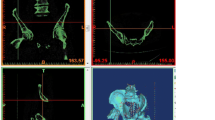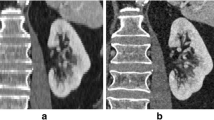Abstract
Medical 3D printing of anatomical models is being increasingly applied in healthcare facilities. The accuracy of such 3D-printed anatomical models is an important aspect of their overall quality control. The purpose of this research was to test whether the accuracy of a variety of anatomical models 3D printed using Material Extrusion (MEX) lies within a reasonable tolerance level, defined as less than 1-mm dimensional error. Six medical models spanning across anatomical regions (musculoskeletal, neurological, abdominal, cardiovascular) and sizes (model volumes ranging from ~ 4 to 203 cc) were chosen for the primary study. Three measurement landing blocks were strategically designed within each of the six medical models to allow high-resolution caliper measurements. An 8-cc reference cube was printed as the 7th model in the primary study. In the secondary study, the effect of model rotation and scale was assessed using two of the models from the first study. All models were 3D printed using an Ultimaker 3 printer in triplicates. All absolute measurement errors were found to be less than 1 mm with a maximum error of 0.89 mm. The maximum relative error was 2.78%. The average absolute error was 0.26 mm, and the average relative error was 0.71% in the primary study, and the results were similar in the secondary study with an average absolute error of 0.30 mm and an average relative error of 0.60%. The relative errors demonstrated certain patterns in the data, which were explained based on the mechanics of MEX 3D printing. Results indicate that the MEX process, when carefully assessed on a case-by-case basis, could be suitable for the 3D printing of multi-pathological anatomical models for surgical planning if an accuracy level of 1 mm is deemed sufficient for the application.










Similar content being viewed by others
Availability of Data and Materials
The raw dataset can be shared upon reasonable request for noncommercial purposes.
Code Availability
Not applicable.
References
D. Mitsouras, P. Liacouras, A. Imanzadeh, A.A. Giannopoulos, T. Cai, K.K. Kumamaru, E. George, N. Wake, E.J. Caterson, B. Pomahac, V.B. Ho, G.T. Grant, F.J. Rybicki, Medical 3D printing for the radiologist, Radiographics. 35 (2015) 1965–1988. https://doi.org/10.1148/rg.2015140320.
E. George, P. Liacouras, F.J. Rybicki, D. Mitsouras, Measuring and establishing the accuracy and reproducibility of 3D printed medical models, Radiographics. 37 (2017) 1424–1450. https://doi.org/10.1148/rg.2017160165.
L. Chepelev, N. Wake, J. Ryan, W. Althobaity, A. Gupta, E. Arribas, L. Santiago, D.H. Ballard, K.C. Wang, W. Weadock, C.N. Ionita, D. Mitsouras, J. Morris, J. Matsumoto, A. Christensen, P. Liacouras, F.J. Rybicki, A. Sheikh, Radiological Society of North America (RSNA) 3D printing Special Interest Group (SIG): guidelines for medical 3D printing and appropriateness for clinical scenarios, 3D Print. Med. 4 (2018). https://doi.org/10.1186/s41205-018-0030-y.
F.J. Rybicki, G.T. Grant, 3D printing in medicine: a practical guide for medical professionals, Springer (2017). https://doi.org/10.1007/978-3-319-61924-8_1.
S. Leng, K. McGee, J. Morris, A. Alexander, J. Kuhlmann, T. Vrieze, C.H. McCollough, J. Matsumoto, Anatomic modeling using 3D printing: quality assurance and optimization, 3D Print. Med. 3 (2017). https://doi.org/10.1186/s41205-017-0014-3.
B. Searle, D. Starkey, An investigation into the effect of changing the computed tomography slice reconstruction interval on the spatial replication accuracy of three-dimensional printed anatomical models constructed by fused deposition modelling, J. Med. Radiat. Sci. 67 (2020) 43–53. https://doi.org/10.1002/jmrs.382.
M. Odeh, D. Levin, J. Inziello, F. Lobo Fenoglietto, M. Mathur, J. Hermsen, J. Stubbs, B. Ripley, Methods for verification of 3D printed anatomic model accuracy using cardiac models as an example, 3D Print. Med. 5 (2019) 1–12. https://doi.org/10.1186/s41205-019-0043-1.
P.E. Eltes, L. Kiss, M. Bartos, Z.M. Gyorgy, T. Csakany, F. Bereczki, V. Lesko, M. Puhl, P.P. Varga, A. Lazary, Geometrical accuracy evaluation of an affordable 3D printing technology for spine physical models, J. Clin. Neurosci. 72 (2020) 438–446. https://doi.org/10.1016/j.jocn.2019.12.027.
C.R. Hatz, B. Msallem, S. Aghlmandi, P. Brantner, F.M. Thieringer, Can an entry-level 3D printer create high-quality anatomical models? Accuracy assessment of mandibular models printed by a desktop 3D printer and a professional device, Int. J. Oral Maxillofac. Surg. 49 (2020) 143–148. https://doi.org/10.1016/j.ijom.2019.03.962.
B. Msallem, N. Sharma, S. Cao, F.S. Halbeisen, H.-F. Zeilhofer, F.M. Thieringer, Evaluation of the dimensional accuracy of 3D-printed anatomical mandibular models using FFF, SLA, SLS, MJ, and BJ printing technology, J. Clin. Med. 9 (2020) 817. https://doi.org/10.3390/jcm9030817.
M. Buda, M. Bratos, J.A. Sorensen, Accuracy of 3-dimensional computer-aided manufactured single-tooth implant definitive casts, J. Prosthet. Dent. 120 (2018) 913–918. https://doi.org/10.1016/j.prosdent.2018.02.011.
C.S. Favero, J.D. English, B.E. Cozad, J.O. Wirthlin, M.M. Short, F.K. Kasper, Effect of print layer height and printer type on the accuracy of 3-dimensional printed orthodontic models, Am. J. Orthod. Dentofac. Orthop. 152 (2017) 557–565. https://doi.org/10.1016/j.ajodo.2017.06.012.
N. Nestler, C. Wesemann, B.C. Spies, F. Beuer, A. Bumann, Dimensional accuracy of extrusion- and photopolymerization-based 3D printers: in vitro study comparing printed casts, J. Prosthet. Dent. (2020) 1–8. https://doi.org/10.1016/j.prosdent.2019.11.011.
Z. chen Zhang, P. lun Li, F. ting Chu, G. Shen, Influence of the three-dimensional printing technique and printing layer thickness on model accuracy, J. Orofac. Orthop. 80 (2019) 194–204. https://doi.org/10.1007/s00056-019-00180-y.
M. Salmi, K.S. Paloheimo, J. Tuomi, J. Wolff, A. Mäkitie, Accuracy of medical models made by additive manufacturing (rapid manufacturing), J. Cranio-Maxillofacial Surg. 41 (2013) 603–609. doi:https://doi.org/10.1016/j.jcms.2012.11.041.
P. Ravi, L. Chepelev, N. Lawera, A systematic evaluation of medical 3D printing accuracy of multi-pathological anatomical models for surgical planning manufactured in elastic and rigid material using desktop inverted vat photopolymerization, Med. Phys. 48 (2021) 3223–3233. https://doi.org/10.1002/mp.14850.
L. Brouwers, A. Teutelink, FAJB. van Tilborg, MAC. de Jongh, KWW. Lansink, M. Bemelman, Validation study of 3D-printed anatomical models using 2 PLA printers for preoperative planning in trauma surgery, a human cadaver study. Eur J. Trauma Emerg. Surg. 45 (2019) 1013–1020. https://doi.org/10.1007/s00068-018-0970-3.
M. Chung, N. Radacsi, C. Robert, E.D. McCarthy, A. Callanan, N. Conlisk, P.R. Hoskins, V. Koutsos, On the optimization of low-cost FDM 3D printers for accurate replication of patient-specific abdominal aortic aneurysm geometry, 3D Print. Med. 4 (2018) 0–9. https://doi.org/10.1186/s41205-017-0023-2.
B.N. Turner, S.A. Gold, A review of melt extrusion additive manufacturing processes: II. Materials, dimensional accuracy, and surface roughness, Rapid Prototyp. J. 21 (2015) 250–261. https://doi.org/10.1108/RPJ-02-2013-0017.
Author information
Authors and Affiliations
Contributions
FJR and LC conceived the study. PR segmented the models, measured the accuracy, analyzed data, and drafted the paper. FJR and LC critically revised the paper. GVS and BSJ 3D printed the models and provided input regarding the 3D-printing process. All authors provided textual contributions to the manuscript draft. All others contributed to revising the manuscript and approved the final version.
Corresponding author
Ethics declarations
Ethics Approval
Not applicable.
Consent to Participate
Not applicable.
Consent for Publication
Not applicable.
Conflict of Interest
The authors declare no competing interests.
Additional information
Publisher's Note
Springer Nature remains neutral with regard to jurisdictional claims in published maps and institutional affiliations.
Rights and permissions
About this article
Cite this article
Ravi, P., Chepelev, L.L., Stichweh, G.V. et al. Medical 3D Printing Dimensional Accuracy for Multi-pathological Anatomical Models 3D Printed Using Material Extrusion. J Digit Imaging 35, 613–622 (2022). https://doi.org/10.1007/s10278-022-00614-x
Received:
Revised:
Accepted:
Published:
Issue Date:
DOI: https://doi.org/10.1007/s10278-022-00614-x




